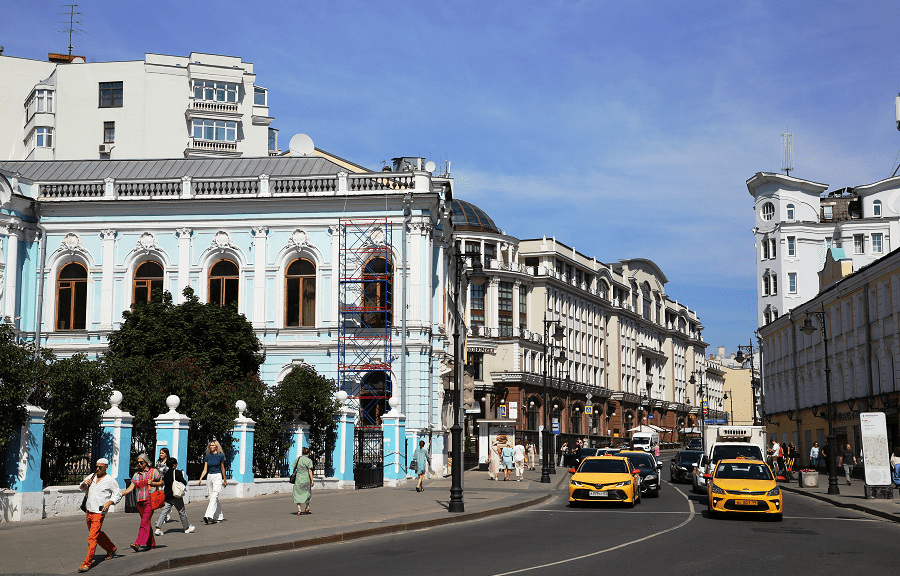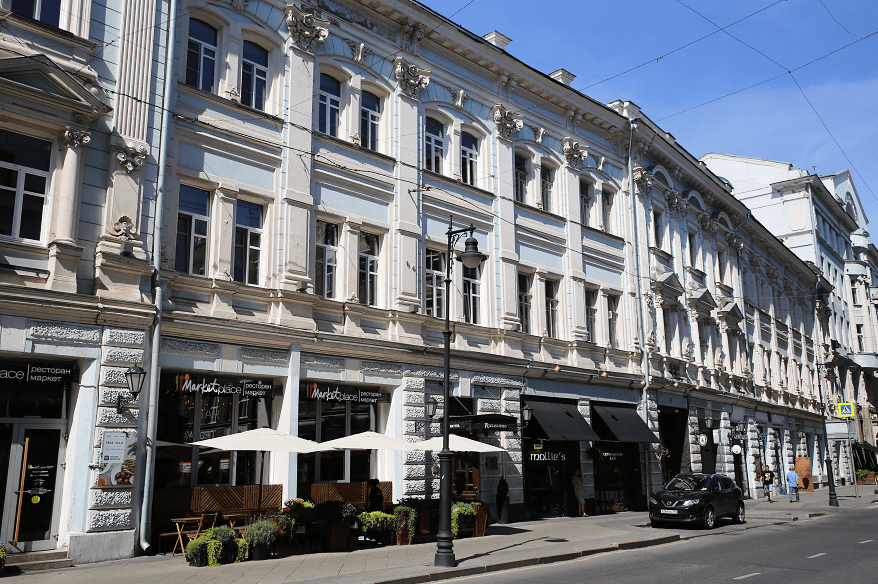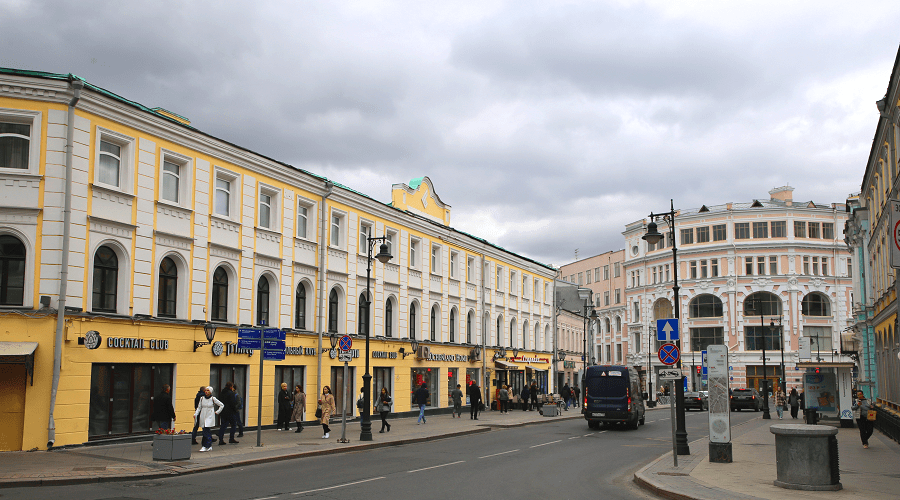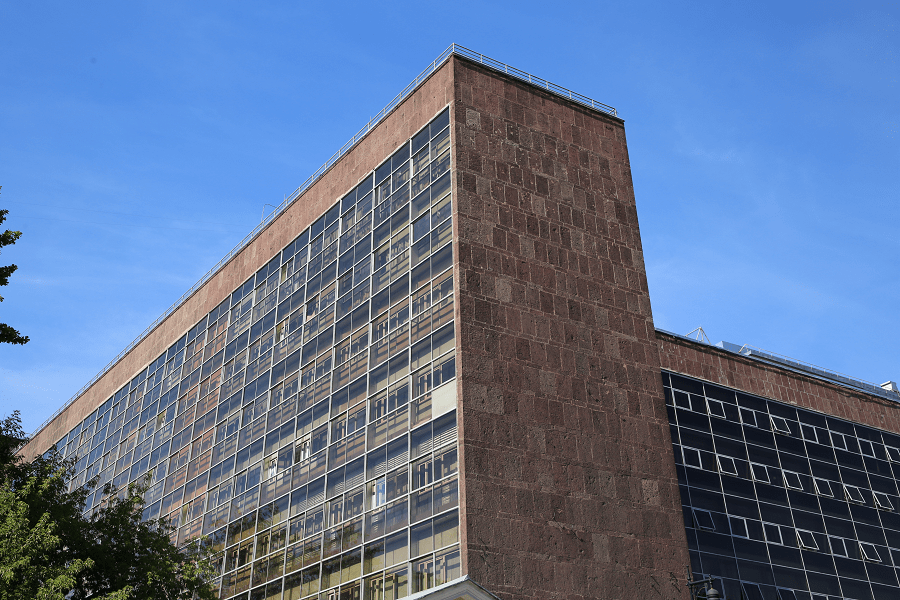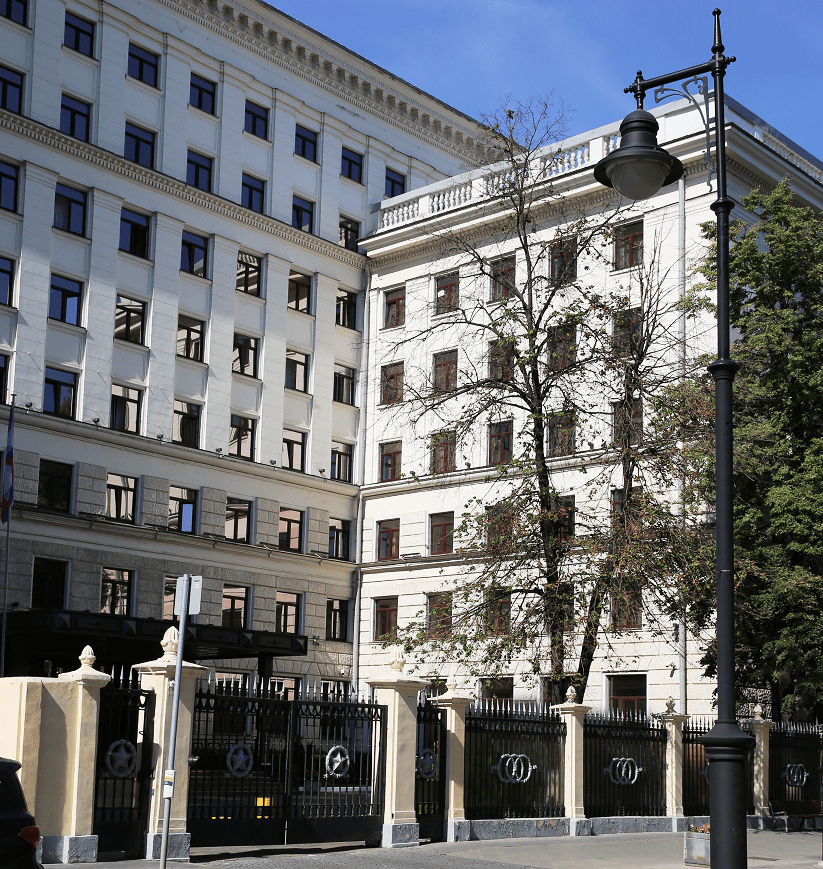Myasnitskaya Street (in the 16th-17th centuries – Frolovskaya Street and Evplovskaya Street, in 1918-1935 – Pervomaiskaya Street, in 1935-1990 – Kirov Street) – a street in the Central Administrative District of Moscow (Basmanny and Krasnoselsky districts). Passes from Lubyanskaya Square to Sadovaya-Spasskaya Street (Garden Ring). The numbering of houses begins from Lubyanskaya Square.
The history of the street has been known since 1482 when Ivan III settled the families of Novgorod boyars and merchants in Moscow, and the Church of the Assumption of the Blessed Virgin Mary was erected outside the Nikolsky Gates of Kitay-Gorod on Bor (it was better known as Grebnevskaya – after the name of the icon of the Mother of God).
Under Peter I, Myasnitskaya became the road between the Kremlin and the German settlement, along which the tsar constantly traveled. Nobles and the new aristocracy began to settle in the street and Prince Menshikov acquired a large property there. On the plan of Moscow in 1767, several houses are shown as made of stone, while the main part of the building of the street was wooden. Behind the houses were kitchen gardens and orchards with ponds.
It remained aristocratic in the first half of the 19th century; later, mainly merchants and manufacturers replaced the nobles. During the fire of 1812, all the wooden houses on the street burned down. In 1813, by the decision of the Commission on the Structure of Moscow, the street was expanded by 25 meters and new stone houses began to be erected on the new red line.
Main attractions
On the odd side
No. 1/2 – The building of state security agencies on Lubyanka (1897-1900, architect A.V. Ivanov; 1928-1933, architect A.Ya. Langman, together with I.G. Bezrukov; 1983 – A.V. Shchusev designed it).
No. 3 – The building of the Moscow Spiritual Consistory (1899, architect V. G. Sretensky; architect I. E. Bondarenko carried out construction). Now the Main Directorate of the Traffic Police of the Ministry of Internal Affairs of the Russian Federation is located here.
No. 3 (right building) – Profitable house of the Moscow Theological Consistory (1910, architect P. A. Vinogradov). The consistory leased the building for trade.
No. 5/12 – Profitable building with offices and shops of G. A. Koeppen, (1907-1908, architect R. I. Klein).
No. 7/3 – Chertkov’s estate. House of the Tatar prince Ivan, late 17th century. Later the house of Prince A. G. Dolgorukov.
No. 7, p. 9 (in the depths, closer to Malaya Lubyanka) – Profitable house of N. A. Gagarina – N. N. Obidina (1902), an identified object of cultural heritage.
No. 9/4 – Residential building (second half of the 18th century; 1780; 1784; 1877).
No. 13 – Profitable possessions of S. V. Davydova – Kh. D. Spiridonov.
No. 13, p. 1 – Profitable house of S. V. Davydova (1898, architect Semen Eibushitz), an object of cultural heritage of regional significance.
No. 13, p. 2 – Trading premises of S. V. Davydova (1913, civil engineer B. M. Velikovsky; 1934), a valuable city-forming object.
No. 13, p. 3 – Profitable house with shops S. V. Davydova – Kh. D. Spiridonova (mid-19th century; 1863-1865), an identified object of cultural heritage.
No. 13, p. 4 – The main house of the profitable ownership of A. P. Nilus – Kh. D. Spiridonov – S. V. Davydova, the Royal Hotel (based on the Saltykov estate) (XVIII century), an identified object of cultural heritage. Chemist D. I. Mendeleev and writers G. I. Uspensky and V. A. Gilyarovskiy stayed in this building.
No. 13, p. 5 – Profitable house of H. D. Spiridonov (1897, architect Semen Eibushitz).
No. 15 – Profitable house of I. E. Kuznetsov (“House with a lion”) (1908-1910, architects – A. N. Milyukov, B. M. Velikovsky, with the participation of V. A. Vesnin and A. A. Vesnin), an object of cultural heritage of regional significance.
No. 17 – The complex of buildings of the Ermakovskaya alms house.
No. 17, p. 2 – The building of the Ermakovskaya alms house – a residential building (1878-1879, architect V.F. Ivanov; built on one floor in the 1950s), a valuable city-forming object. In the 1950s-1960s, Irakli Andronikov lived in the house.
No. 19 – Profitable house with a tea shop by S. V. Perlov (1890, architect – R. I. Klein). In 1885-1896, K. K. Gippius redesigned itin the Chinese style.
No. 21 – The complex of buildings of the Moscow School of Painting, Sculpture and Architecture. Yushkov’s house. Presumably,the architect V.I. Bazhenov built it in the 1780s and 1790s. Currently, the Russian Academy of Painting, Sculpture and Architecture occupies the building.
No. 35 – Administrative building. In 1989, according to the design of the architect D.S. Solopov, the façade overlooking Turgenevskaya Square was added to the building in the 1930s.
No. 37, pp. 1, 3 – City estate of Dokuchaev – Soldatenkov (includes chambers of the 17th – early 18th centuries; the architect A.G. Grigoriev rebuilt the main house in 1819-1821 according to the project of J. Bove; the architect A.I. Rezanov rebuilt it in the middle of the 19th century), an object of cultural heritage of federal significance. At the beginning of the Great Patriotic War, the Headquarters of the Supreme High Command was located here. Later the Reception of the Minister of Defense of the USSR and then the Reception of the Minister of Defense of Russia were located here).
No. 39 – Building of the Tsentrosoyuz (1936, architect N. Ya. Colli, designed by Le Corbusier). Built on the site of the Church of St. Nicholas Myasnitsky. In 2015, A. Tyrtyshnikov’s monument to Le Corbusier was erected in front of the building.
No. 41 is an apartment house with shops of Anna Perlova, who owned house No. 19 after the death of her husband.
No. 43 – House of A. I. Lobanov-Rostovsky. Built-in the half of the 19th century.
No. 43, p. 2 – The educational building of the Real School of K. P. Voskresensky (1906, architect A. V. Kuznetsov), an identified object of cultural heritage.
No. 47 – Gostorg building. One of the early examples of constructivism. It was built in 1925-1927 according to the project of the architect B. M. Velikovsky, with the participation of A. Ya. Langman, M. O. Barshch, G. G. Vegman, V. N. Vladimirov and M. V. Gaken. An object of cultural heritage of regional significance. The building currently houses Rostourism.
No. 49/22 – Residential house of the merchant Natalya Aplaksina (1830-1840s). In Soviet times, the State Institute of Musical Sciences occupied the building.
On the even side
No. 6/3, building 4 – Profitable house of N. D. Stakheev 1897, architect M. F. Bugrovsky; 1970s; 1986, architects: A. V. Bokov, E. Budin, B. Chernov, I. Ivanov) – KGB Computing Center (1987, architects B. V. Paluy and G. V. Makarevich) with the State Museum of V. V. Mayakovsky. Near the building, there is a sculptural portrait of Mayakovsky (sculptor Yu. G. Orekhov, architect B. V. Paluy).
No. 6/3, buildings 1, 5 – Profitable house of N. D. Stakheev with shops (1897, architect M. F. Bugrovsky; three upper floors were built in 1986 – B. V. Paluy and G. V. Makarevich), a valuable city-forming object. The Detsky Mir store occupied the first and second floors until the mid-1950s and then moved to a specially designed building on the opposite side of Lubyanka Square. Since 1957, the Biblio-Globus bookstore has been located in the house.
No. 8/2 – Trading House of the Partnership of M. S. Kuznetsov (1898-1903, architect – F. O. Shekhtel), a valuable city-forming object.
No. 10 – Compound of the Vyatka bishop (beginning of the 19th century).
No. 12 – Volkova’s House (1833). For several decades, the Okhotnik (Hunter shop) store has operated in the house.
No. 14 – Compound of the Tula bishop (beginning of the 19th century).
No. 16 – Administrative building (2000s). Previously, I. Sokolov’s apartment building stood on this site.
No. 18 – Profitable house with shops of I. P. Butikov – M. I. Mishin (XIX century; in 1902-1903, the architect I. T. Baryutin overhauled it with a change in the facade), a declared object of cultural heritage.
No. 20 / 3a, building 2 – The main house of the Koltsov-Mosalskys – the profitable possession of the Varvarin Joint-Stock Company – the administrative complex “Neftesindikat” (mid-18th century; 1900; 1925-1926, architect S. F. Voskresensky), a valuable city-forming object.
No. 22/5/2 – Profitable possessions of the Sytovs.
No. 22/5/2, building 1a – Profitable building with a store by I. E. and S. I. Sytovs (1873, architect V. F. Zhigardlovich; 1930s), a valuable city-forming object.
No. 22/5/2, building 1b – Profitable house of I. E. and S. I. Sytovs (II half of the 18th century; 1878; 1895, architect A. N. Knabe), a valuable city-forming object.
No. 22/5/2, building 2 – Profitable possession of I. E. and S. I. Sytovs (1861), a valuable city-forming object.
No. 24/1 – Profitable building of the Stroganov School of Technical Drawing (1906, architect – F. O. Shekhtel), an object of cultural heritage of federal significance.
No. 26 – The complex of buildings of the Moscow Imperial Post Office and Telegraph (XVIII century – early XX century, architects H. Fichtner, A. Cavos, A. P. Popov). The outbuildings were rebuilt in 1904 according to the project of architect I. P. Zalessky. Now – the European-Asian exchange. The building is an object of cultural heritage of regional significance. Included in the Red Book of Archnadzor (electronic catalogue of Moscow’s immovable cultural heritage under threat).
No. 30/1/2, building 2 – Profitable house of A. I. Vinogradova (1886, architect B. V. Freidenberg), a valuable city-forming object.
No. 30/1/2, building 3 – Profitable house of A. I. Vinogradova (1888-1889, architects V. A. Bader, K. A. Mikhailov; 1892, architect G. Sorokin; 1897).
No. 34 – Profitable House (1887, architect S. S. Eybusic) In 1993, Jastrebac (Yugoslavia) reconstructed the building for the regional representative office of Inex Interexport (Reconstruction project – Serbian architect Zoran T. Vasic).
No. 36 – Profitable house of A.I. Zimina-Derozhinskaya. She owned several houses in Moscow, including her mansion in Kropotkinsky lane.
No. 38 – Profitable house of A.P. Langovoy (1904-1905, architect N.L. Shevyakov).
No. 40, pp. 1-16 – The complex of buildings of the “Old” Imperial Moscow Post Office.
No. 40, Building 16 – Newspaper post office (1931, architect K. I. Solomonov), an identified object of cultural heritage.
No. 40a – Residential building (1948, architect A. T. Kapustina). Academicians M. V. Keldyshand G. S. Byushgens lived in the house.
No. 42 – The city estate of I. I. Baryshnikov (XVII-beginning of the XVIII centuries; 1793-1796; 1797-1802, architect M. F. Kazakov; restored by architect S. F. Kulagin). Currently, the building houses the editorial office of the newspaper “Arguments and Facts”. The building is classified as a cultural heritage site of federal significance.
No. 44/1 – The main house of the estate of P. Ya. Golitsyn – N. F. von Meck – N. D. Stakheev. Built-in thefirst half of the 18th-19th centuries. M.F. Bugrovskyrebuilt it in 1897-1899. An object of cultural heritage of federal significance.
No. 48 – Profitable house of doctor P. Voronin was built in 1895. On the last floor of the building, there was an apartment workshop of the artist Konstantin Korovin. From 1974-1983, the artist Ivan Dergilev lived in Korovin’s former studio apartment. In Soviet times, the Dieata store occupied the first floor. Now it is the Myasnitskaya Plaza business centre.
No. 50 – Pullman Business Center. Previously, on the site of a modern building, there was an apartment building designed in 1911 according to the project of architect M.A. Aladyin.
Transport
- Lubyanka metro station – at the beginning of the street.
- Chistye Prudy, Turgenevskaya, Sretensky Boulevard – in the middle of the street.
- Krasnye Vorota – 170 meters from the end of the street.
Bus number 122.
Attractions around: Bolshoi Theatre, Manezhnaya Square, Ploschad Revolyutsii (square), State Duma building, House of the Unions, Tretyakovskiy proezd, Central Children’s Store, Lubyanka Building, Metropol Hotel, Red Square, Tverskaya street.
See more streets and squares in Moscow, monuments of Moscow, architecture of Moscow.



